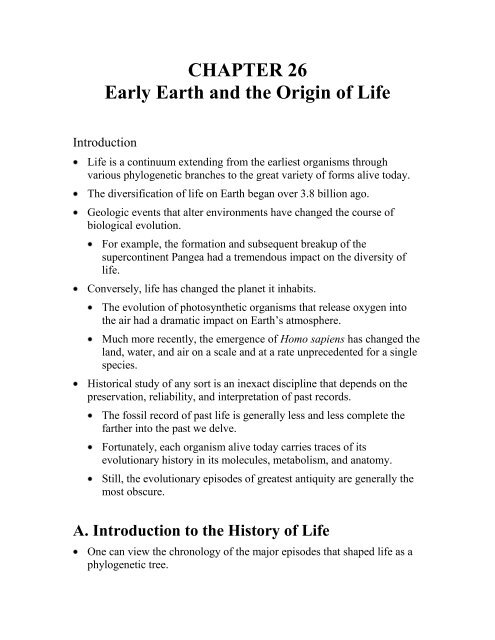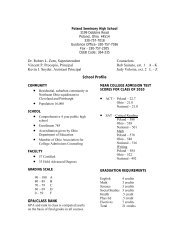CHAPTER 26 Early Earth and the Origin of Life
CHAPTER 26 Early Earth and the Origin of Life
CHAPTER 26 Early Earth and the Origin of Life
You also want an ePaper? Increase the reach of your titles
YUMPU automatically turns print PDFs into web optimized ePapers that Google loves.
<strong>CHAPTER</strong> <strong>26</strong><br />
<strong>Early</strong> <strong>Earth</strong> <strong>and</strong> <strong>the</strong> <strong>Origin</strong> <strong>of</strong> <strong>Life</strong><br />
Introduction<br />
<strong>Life</strong> is a continuum extending from <strong>the</strong> earliest organisms through<br />
various phylogenetic branches to <strong>the</strong> great variety <strong>of</strong> forms alive today.<br />
The diversification <strong>of</strong> life on <strong>Earth</strong> began over 3.8 billion ago.<br />
Geologic events that alter environments have changed <strong>the</strong> course <strong>of</strong><br />
biological evolution.<br />
For example, <strong>the</strong> formation <strong>and</strong> subsequent breakup <strong>of</strong> <strong>the</strong><br />
supercontinent Pangea had a tremendous impact on <strong>the</strong> diversity <strong>of</strong><br />
life.<br />
Conversely, life has changed <strong>the</strong> planet it inhabits.<br />
The evolution <strong>of</strong> photosyn<strong>the</strong>tic organisms that release oxygen into<br />
<strong>the</strong> air had a dramatic impact on <strong>Earth</strong>’s atmosphere.<br />
Much more recently, <strong>the</strong> emergence <strong>of</strong> Homo sapiens has changed <strong>the</strong><br />
l<strong>and</strong>, water, <strong>and</strong> air on a scale <strong>and</strong> at a rate unprecedented for a single<br />
species.<br />
Historical study <strong>of</strong> any sort is an inexact discipline that depends on <strong>the</strong><br />
preservation, reliability, <strong>and</strong> interpretation <strong>of</strong> past records.<br />
The fossil record <strong>of</strong> past life is generally less <strong>and</strong> less complete <strong>the</strong><br />
far<strong>the</strong>r into <strong>the</strong> past we delve.<br />
Fortunately, each organism alive today carries traces <strong>of</strong> its<br />
evolutionary history in its molecules, metabolism, <strong>and</strong> anatomy.<br />
Still, <strong>the</strong> evolutionary episodes <strong>of</strong> greatest antiquity are generally <strong>the</strong><br />
most obscure.<br />
A. Introduction to <strong>the</strong> History <strong>of</strong> <strong>Life</strong><br />
One can view <strong>the</strong> chronology <strong>of</strong> <strong>the</strong> major episodes that shaped life as a<br />
phylogenetic tree.
Alternatively, we can view <strong>the</strong>se episodes with a clock analogy.<br />
1. <strong>Life</strong> on <strong>Earth</strong> originated between 3.5 <strong>and</strong> 4.0<br />
billion years ago<br />
For <strong>the</strong> first three-quarters <strong>of</strong> evolutionary history, <strong>Earth</strong>’s only<br />
organisms were microscopic <strong>and</strong> mostly unicellular.<br />
The <strong>Earth</strong> formed about 4.5 billion years ago, but rock bodies left over<br />
from <strong>the</strong> origin <strong>of</strong> <strong>the</strong> solar system bombarded <strong>the</strong> surface for <strong>the</strong> first<br />
few hundred million years, making it unlikely that life could survive.<br />
No clear fossils have been found in <strong>the</strong> oldest surviving <strong>Earth</strong> rocks,<br />
from 3.8 billion years ago.<br />
The oldest fossils that have been uncovered were embedded in rocks<br />
from western Australia from 3.5 billion years ago.<br />
The presence <strong>of</strong> <strong>the</strong>se fossils, resembling bacteria, would imply that<br />
life originated much earlier.<br />
This may have been as early as 3.9 billion years ago, when <strong>Earth</strong><br />
began to cool to a temperature at which liquid water could exist.<br />
2. Prokaryotes dominated evolutionary history<br />
from 3.5 to 2.0 billion years ago<br />
Prokaryotes dominated evolutionary history from about 3.5 to 2.0 billion<br />
years ago.<br />
The fossil records supports <strong>the</strong> hypo<strong>the</strong>sis that <strong>the</strong> earliest organisms<br />
were prokaryotes.<br />
Relatively early, prokaryotes diverged into two main evolutionary<br />
branches, <strong>the</strong> bacteria <strong>and</strong> <strong>the</strong> archaea.<br />
Representatives from both groups thrive in various environments<br />
today.<br />
Two rich sources for early prokaryote fossils are stromatolites<br />
(fossilized layered microbial mats) <strong>and</strong> sediments from ancient<br />
hydro<strong>the</strong>rmal vent habitats.
This indicates that <strong>the</strong> metabolism <strong>of</strong> prokaryotes was already diverse<br />
over 3 billion years ago.<br />
3. Oxygen began accumulating in <strong>the</strong> atmosphere<br />
about 2.7 billion years ago<br />
Photosyn<strong>the</strong>sis probably evolved very early in prokaryotic history.<br />
The metabolism <strong>of</strong> early versions <strong>of</strong> photosyn<strong>the</strong>sis did not split water<br />
<strong>and</strong> liberate oxygen.<br />
Cyanobacteria, photosyn<strong>the</strong>tic organisms that split water <strong>and</strong> produce O 2<br />
as a byproduct, evolved over 2.7 billion years ago.<br />
This early oxygen initially reacted with dissolved iron to form <strong>the</strong><br />
precipitate iron oxide.<br />
This can be seen today in b<strong>and</strong>ed iron formations.<br />
About 2.7 billion years ago oxygen began accumulating in <strong>the</strong><br />
atmosphere <strong>and</strong> terrestrial rocks with iron began oxidizing.<br />
While oxygen accumulation was gradual between 2.7 <strong>and</strong> 2.2 billion<br />
years ago, it shot up to 10% <strong>of</strong> current values shortly afterward.<br />
This “corrosive” O 2 had an enormous impact on life, dooming many<br />
prokaryote groups.<br />
Some species survived in habitats that remained anaerobic.<br />
O<strong>the</strong>r species evolved mechanisms to use O 2 in cellular respiration,<br />
which uses oxygen to help harvest <strong>the</strong> energy stored in organic<br />
molecules.<br />
4. Eukaryotic life began by 2.1 billion years ago<br />
Eukaryotic cells are generally larger <strong>and</strong> more complex than prokaryotic<br />
cells.<br />
In part, this is due to <strong>the</strong> apparent presence <strong>of</strong> <strong>the</strong> descendents <strong>of</strong><br />
“endosymbiotic prokaryotes” that evolved into mitochondria <strong>and</strong><br />
chloroplasts.<br />
While <strong>the</strong>re is some evidence <strong>of</strong> earlier eukaryotic fossils, <strong>the</strong> first clear<br />
eukaryote appeared about 2.1 billion years ago.
O<strong>the</strong>r evidence places <strong>the</strong> origin <strong>of</strong> eukaryotes to as early as 2.7<br />
billion years ago.<br />
This places <strong>the</strong> earliest eukaryotes at <strong>the</strong> same time as <strong>the</strong> oxygen<br />
revolution that changed <strong>the</strong> <strong>Earth</strong>’s environment so dramatically.<br />
The evolution <strong>of</strong> chloroplasts may be part <strong>of</strong> <strong>the</strong> explanation for this<br />
temporal correlation.<br />
Ano<strong>the</strong>r eukaryotic organelle, <strong>the</strong> mitochondrion, turned <strong>the</strong><br />
accumulating O 2 to metabolic advantage through cellular respiration.<br />
5. Multicellular eukaryotes evolved by 1.2 billion<br />
years ago<br />
A great range <strong>of</strong> eukaryotic unicellular forms evolved into <strong>the</strong> diversity<br />
<strong>of</strong> present-day “protists.”<br />
Multicellular organisms, differentiating from a single-celled precursor,<br />
appear 1.2 billion years ago as fossils, or perhaps as early as 1.5 billion<br />
years ago from molecular clock estimates.<br />
Recent fossil finds from China have produced a diversity <strong>of</strong> algae <strong>and</strong><br />
animals from 570 million years ago, including beautifully preserved<br />
embryos.<br />
Geologic evidence for a severe ice age (“snowball <strong>Earth</strong>” hypo<strong>the</strong>sis)<br />
from 750 to 570 million years ago may be responsible for <strong>the</strong> limited<br />
diversity <strong>and</strong> distribution <strong>of</strong> multicellular eukaryotes until <strong>the</strong> very late<br />
Precambrian.<br />
During this period, most life would have been confined to deep-sea<br />
vents <strong>and</strong> hot springs or those few locations where enough ice melted<br />
for sunlight to penetrate <strong>the</strong> surface waters <strong>of</strong> <strong>the</strong> sea.<br />
The first major diversification <strong>of</strong> multicellular eukaryotic organisms<br />
corresponds to <strong>the</strong> time <strong>of</strong> <strong>the</strong> thawing <strong>of</strong> snowball <strong>Earth</strong>.<br />
6. Animal diversity exploded during <strong>the</strong> early<br />
Cambrian period
A second radiation <strong>of</strong> eukaryotic forms produced most <strong>of</strong> <strong>the</strong> major<br />
groups <strong>of</strong> animals during <strong>the</strong> early Cambrian period.<br />
Cnidarians (<strong>the</strong> phylum that includes jellies) <strong>and</strong> poriferans (sponges)<br />
were already present in <strong>the</strong> late Precambrian.<br />
However, most <strong>of</strong> <strong>the</strong> major groups (phyla) <strong>of</strong> animals make <strong>the</strong>ir first<br />
fossil appearances during <strong>the</strong> relatively short span <strong>of</strong> <strong>the</strong> Cambrian<br />
period’s first 20 million years.<br />
7. Plants, fungi, <strong>and</strong> animals colonized <strong>the</strong> l<strong>and</strong><br />
about 500 million years ago<br />
The colonization <strong>of</strong> l<strong>and</strong> was one <strong>of</strong> <strong>the</strong> pivotal milestones in <strong>the</strong> history<br />
<strong>of</strong> life.<br />
There is fossil evidence that cyanobacteria <strong>and</strong> o<strong>the</strong>r photosyn<strong>the</strong>tic<br />
prokaryotes coated damp terrestrial surfaces well over a billion years<br />
ago.<br />
However, macroscopic life in <strong>the</strong> form <strong>of</strong> plants, fungi, <strong>and</strong> animals<br />
did not colonize l<strong>and</strong> until about 500 million years ago, during <strong>the</strong><br />
early Paleozoic era.<br />
The gradual evolution from aquatic to terrestrial habitats required<br />
adaptations to prevent dehydration <strong>and</strong> to reproduce on l<strong>and</strong>.<br />
For example, plants evolved a waterpro<strong>of</strong> coating <strong>of</strong> wax on <strong>the</strong>ir<br />
leaves to slow <strong>the</strong> loss <strong>of</strong> water.<br />
Plants colonized l<strong>and</strong> in association with fungi.<br />
Fungi aid <strong>the</strong> absorption <strong>of</strong> water <strong>and</strong> nutrients from <strong>the</strong> soil.<br />
The fungi obtain organic nutrients from <strong>the</strong> plant.<br />
This ancient symbiotic association is evident in some <strong>of</strong> <strong>the</strong> oldest<br />
fossilized roots.<br />
Plants created new opportunities for all life, including herbivorous (planteating)<br />
animals <strong>and</strong> <strong>the</strong>ir predators.<br />
The most widespread <strong>and</strong> diverse terrestrial animals are certain<br />
arthropods (including insects <strong>and</strong> spiders) <strong>and</strong> certain vertebrates<br />
(including amphibians, reptiles, birds, <strong>and</strong> mammals).
Most orders <strong>of</strong> modern mammals, including primates, appeared 50-60<br />
million years ago.<br />
Humans diverged from o<strong>the</strong>r primates only 5 million years ago.<br />
The terrestrial vertebrates, called tetrapods because <strong>of</strong> <strong>the</strong>ir four walking<br />
limbs, evolved from fishes, based on an extensive fossil record.<br />
Reptiles evolved from amphibians; both birds <strong>and</strong> mammals evolved<br />
from reptiles.<br />
Most orders <strong>of</strong> modern mammals, including primates, appeared 50-60<br />
million years ago.<br />
Humans diverged from o<strong>the</strong>r primates only 5 million years ago.<br />
B. The <strong>Origin</strong> <strong>of</strong> <strong>Life</strong><br />
Sometime between about 4.0 billion years ago, when <strong>the</strong> <strong>Earth</strong>’s crust<br />
began to solidify, <strong>and</strong> 3.5 billion years ago when stromatolites appear, <strong>the</strong><br />
first organisms came into being.<br />
We will never know for sure, <strong>of</strong> course, how life on <strong>Earth</strong> began.<br />
But science seeks natural causes for natural phenomena.<br />
1. The first cells may have originated by chemical<br />
evolution on a young <strong>Earth</strong>: an overview<br />
Most scientists favor <strong>the</strong> hypo<strong>the</strong>sis that life on <strong>Earth</strong> developed from<br />
nonliving materials that became ordered into aggregates that were<br />
capable <strong>of</strong> self-replication <strong>and</strong> metabolism.<br />
From <strong>the</strong> time <strong>of</strong> <strong>the</strong> Greeks until <strong>the</strong> 19th century, it was common<br />
“knowledge” that life could arise from nonliving matter, an idea called<br />
spontaneous generation.<br />
While this idea had been rejected by <strong>the</strong> late Renaissance for<br />
macroscopic life, it persisted as an explanation for <strong>the</strong> rapid growth <strong>of</strong><br />
microorganisms in spoiled foods.<br />
In 1862, Louis Pasteur conducted broth experiments that rejected <strong>the</strong><br />
idea <strong>of</strong> spontaneous generation even for microbes.
A sterile broth would “spoil” only if microorganisms could invade from<br />
<strong>the</strong> environment.<br />
All life today arises only by <strong>the</strong> reproduction <strong>of</strong> preexisting life, <strong>the</strong><br />
principle <strong>of</strong> biogenesis.<br />
Although <strong>the</strong>re is no evidence that spontaneous generation occurs today,<br />
conditions on <strong>the</strong> early <strong>Earth</strong> were very different.<br />
There was very little atmospheric oxygen to attack complex<br />
molecules.<br />
Energy sources, such as lightning, volcanic activity, <strong>and</strong> ultraviolet<br />
sunlight, were more intense than what we experience today.<br />
One credible hypo<strong>the</strong>sis is that chemical <strong>and</strong> physical processes in<br />
<strong>Earth</strong>’s primordial environment eventually produced simple cells.<br />
Under one hypo<strong>the</strong>tical scenario this occurred in four stages.<br />
1) The abiotic syn<strong>the</strong>sis <strong>of</strong> small organic molecules.<br />
2) The joining <strong>the</strong>se small molecules into polymers.<br />
3) The origin <strong>of</strong> self-replicating molecules.<br />
4) The packaging <strong>of</strong> <strong>the</strong>se molecules into “protobionts.”<br />
This hypo<strong>the</strong>sis leads to predictions that can be tested in <strong>the</strong> laboratory.<br />
2. Abiotic syn<strong>the</strong>sis <strong>of</strong> organic monomers is a<br />
testable hypo<strong>the</strong>sis<br />
In <strong>the</strong> 1920s, A.I. Oparin <strong>and</strong> J.B.S. Haldane independently postulated<br />
that conditions on <strong>the</strong> early <strong>Earth</strong> favored <strong>the</strong> syn<strong>the</strong>sis <strong>of</strong> organic<br />
compounds from inorganic precursors.<br />
They reasoned that this cannot happen today because high levels <strong>of</strong><br />
oxygen in <strong>the</strong> atmosphere attack chemical bonds.<br />
The reducing environment in <strong>the</strong> early atmosphere would have promoted<br />
<strong>the</strong> joining <strong>of</strong> simple molecules to form more complex ones.<br />
The considerable energy required to make organic molecules could be<br />
provided by lightning <strong>and</strong> <strong>the</strong> intense UV radiation that penetrated <strong>the</strong><br />
primitive atmosphere.
Young suns emit more UV radiation <strong>and</strong> <strong>the</strong> lack <strong>of</strong> an ozone layer in<br />
<strong>the</strong> early atmosphere would have allowed this radiation to reach <strong>the</strong><br />
<strong>Earth</strong>.<br />
In 1953, Stanley Miller <strong>and</strong> Harold Urey tested <strong>the</strong> Oparin-Haldane<br />
hypo<strong>the</strong>sis by creating, in <strong>the</strong> laboratory, <strong>the</strong> conditions that had been<br />
postulated for early <strong>Earth</strong>.<br />
They discharged sparks in an “atmosphere” <strong>of</strong> gases <strong>and</strong> water vapor.<br />
The Miller-Urey experiments produced a variety <strong>of</strong> amino acids <strong>and</strong><br />
o<strong>the</strong>r organic molecules.<br />
The atmosphere in <strong>the</strong> Miller-Urey model consisted <strong>of</strong> H 2 O, H 2 , CH 4 ,<br />
<strong>and</strong> NH 3 , probably a more strongly reducing environment than is<br />
currently believed to have existed on early <strong>Earth</strong>.<br />
O<strong>the</strong>r attempts to reproduce <strong>the</strong> Miller-Urey experiment with o<strong>the</strong>r gas<br />
mixtures also produced organic molecules, although in smaller quantities.<br />
The Miller-Urey experiments still stimulate debate on <strong>the</strong> origin <strong>of</strong><br />
<strong>Earth</strong>’s early stockpile <strong>of</strong> organic ingredients.<br />
Alternate sites proposed for <strong>the</strong> syn<strong>the</strong>sis <strong>of</strong> organic molecules<br />
include submerged volcanoes <strong>and</strong> deep-sea vents where hot water <strong>and</strong><br />
minerals gush into <strong>the</strong> deep ocean.<br />
Ano<strong>the</strong>r possible source for organic monomers on <strong>Earth</strong> is from<br />
space, including via meteorites containing organic molecules that<br />
crashed to <strong>Earth</strong>.<br />
3. Laboratory simulations <strong>of</strong> early-<strong>Earth</strong><br />
conditions have produced organic polymers<br />
The abiotic origin hypo<strong>the</strong>sis predicts that monomers should link to form<br />
polymers without enzymes <strong>and</strong> o<strong>the</strong>r cellular equipment.<br />
Researchers have produced polymers, including polypeptides, after<br />
dripping solutions <strong>of</strong> monomers onto hot s<strong>and</strong>, clay, or rock.<br />
Similar conditions likely existed on <strong>the</strong> early <strong>Earth</strong> at deep-sea vents<br />
or when dilute solutions <strong>of</strong> monomers splashed onto fresh lava.
4. RNA may have been <strong>the</strong> first genetic material<br />
<strong>Life</strong> is defined partly by inheritance.<br />
Today, cells store <strong>the</strong>ir genetic information as DNA, transcribe select<br />
sections into RNA, <strong>and</strong> translate <strong>the</strong> RNA messages into enzymes <strong>and</strong><br />
o<strong>the</strong>r proteins.<br />
Many researchers have proposed that <strong>the</strong> first hereditary material was<br />
RNA, not DNA.<br />
Because RNA can also function as an enzyme, it helps resolve <strong>the</strong><br />
paradox <strong>of</strong> which came first, genes or enzymes.<br />
Short polymers <strong>of</strong> ribonucleotides can be syn<strong>the</strong>sized abiotically in <strong>the</strong><br />
laboratory.<br />
If <strong>the</strong>se polymers are added to a solution <strong>of</strong> ribonucleotide monomers,<br />
sequences up to 10 bases long are copied from <strong>the</strong> template according<br />
to <strong>the</strong> base-pairing rules.<br />
If zinc is added, <strong>the</strong> copied sequences may reach 40 nucleotides with<br />
less than 1% error.<br />
In <strong>the</strong> 1980s Thomas Cech discovered that RNA molecules are important<br />
catalysts in modern cells.<br />
RNA catalysts, called ribozymes, remove introns from RNA.<br />
Ribozymes also help catalyze <strong>the</strong> syn<strong>the</strong>sis <strong>of</strong> new RNA polymers.<br />
In <strong>the</strong> pre-biotic world, RNA molecules may have been fully capable <strong>of</strong><br />
ribozyme-catalyzed replication.<br />
Laboratory experiments have demonstrated that RNA sequences can<br />
evolve in abiotic conditions.<br />
RNA molecules have both a genotype (nucleotide sequence) <strong>and</strong> a<br />
phenotype (three-dimensional shape) that interacts with surrounding<br />
molecules.<br />
Under particular conditions, some RNA sequences are more stable <strong>and</strong><br />
replicate faster <strong>and</strong> with fewer errors than o<strong>the</strong>r sequences.<br />
Occasional copying errors create mutations <strong>and</strong> selection screens<br />
<strong>the</strong>se mutations for <strong>the</strong> most stable or <strong>the</strong> best at self-replication.
RNA-directed protein syn<strong>the</strong>sis may have begun as weak binding <strong>of</strong><br />
specific amino acids to bases along RNA molecules, which functioned as<br />
simple templates holding a few amino acids toge<strong>the</strong>r long enough for<br />
<strong>the</strong>m to be linked.<br />
This is one function <strong>of</strong> rRNA today in ribosomes.<br />
If RNA syn<strong>the</strong>sized a short polypeptide that behaved as an enzyme<br />
helping RNA replication, <strong>the</strong>n early chemical dynamics would include<br />
molecular cooperation as well as competition.<br />
5. Protobionts can form by self-assembly<br />
Living cells may have been preceded by protobionts, aggregates <strong>of</strong><br />
abiotically produced molecules.<br />
Protobionts do not reproduce precisely, but <strong>the</strong>y do maintain an internal<br />
chemical environment different from <strong>the</strong>ir surroundings <strong>and</strong> may show<br />
some properties associated with life, metabolism, <strong>and</strong> excitability.<br />
In <strong>the</strong> laboratory, droplets <strong>of</strong> abiotically produced organic compounds,<br />
called liposomes, form when lipids are included in <strong>the</strong> mix.<br />
The lipids form a molecular bilayer at <strong>the</strong> droplet surface, much like <strong>the</strong><br />
lipid bilayer <strong>of</strong> a membrane.<br />
These droplets can undergo osmotic swelling or shrinking in different<br />
salt concentrations.<br />
They also store energy as a membrane potential, a voltage cross <strong>the</strong><br />
surface.<br />
Liposomes behave dynamically, growing by engulfing smaller liposomes<br />
or “giving birth” to smaller liposomes.<br />
If enzymes are included among <strong>the</strong> ingredients, <strong>the</strong>y are incorporated into<br />
<strong>the</strong> droplets.<br />
The protobionts are <strong>the</strong>n able to absorb substrates from <strong>the</strong>ir<br />
surroundings <strong>and</strong> release <strong>the</strong> products <strong>of</strong> <strong>the</strong> reactions catalyzed by <strong>the</strong><br />
enzymes.<br />
Unlike some laboratory models, protobionts that formed in <strong>the</strong> ancient<br />
seas would not have possessed refined enzymes, <strong>the</strong> products <strong>of</strong> inherited<br />
instructions.
However, some molecules produced abiotically do have weak<br />
catalytic capacities.<br />
There could well have been protobioints that had a rudimentary<br />
metabolism that allowed <strong>the</strong>m to modify substances <strong>the</strong>y took in<br />
across <strong>the</strong>ir membranes.<br />
6. Natural selection could refine protobionts<br />
containing hereditary information<br />
Once primitive RNA genes <strong>and</strong> <strong>the</strong>ir polypeptide products were<br />
packaged within a membrane, <strong>the</strong> protobionts could have evolved as<br />
units.<br />
Molecular cooperation could be refined because favorable components<br />
were concentrated toge<strong>the</strong>r, ra<strong>the</strong>r than spread throughout <strong>the</strong><br />
surroundings.<br />
As an example: suppose that an RNA molecule ordered amino acids into<br />
a primitive enzyme that extracted energy from inorganic sulfur<br />
compounds taken up from <strong>the</strong> surroundings<br />
This energy could be used for o<strong>the</strong>r reactions within <strong>the</strong> protobiont,<br />
including <strong>the</strong> replication <strong>of</strong> RNA.<br />
Natural selection would favor such a gene only if its products were<br />
kept close by, ra<strong>the</strong>r than being shared with competing RNA<br />
sequences in <strong>the</strong> environment.<br />
The most successful protobionts would grow <strong>and</strong> split, distributing copies<br />
<strong>of</strong> <strong>the</strong>ir genes to <strong>of</strong>fspring.<br />
Even if only one such protobiont arose initially by <strong>the</strong> abiotic processes<br />
that have been described, its descendants would vary because <strong>of</strong><br />
mutation, errors in copying RNA.<br />
Evolution via differential reproductive success <strong>of</strong> varied individuals<br />
presumably refined primitive metabolism <strong>and</strong> inheritance.<br />
One refinement was <strong>the</strong> replacement <strong>of</strong> RNA as <strong>the</strong> repository <strong>of</strong><br />
genetic information by DNA, a more stable molecule.<br />
Once DNA appeared, RNA molecules would have begun to take on<br />
<strong>the</strong>ir modern roles as intermediates in translation <strong>of</strong> genetic programs.
7. Debates about <strong>the</strong> origin <strong>of</strong> life abound<br />
Laboratory simulations cannot prove that <strong>the</strong>se kinds <strong>of</strong> chemical<br />
processes actually created life on <strong>the</strong> primitive <strong>Earth</strong>.<br />
They describe steps that could have happened.<br />
The origin <strong>of</strong> life is still subject to much speculation <strong>and</strong> alternative<br />
views.<br />
Among <strong>the</strong> debates are whe<strong>the</strong>r organic monomers on early <strong>Earth</strong><br />
were syn<strong>the</strong>sized <strong>the</strong>re or reached <strong>Earth</strong> on comets <strong>and</strong> meteorites.<br />
Major debates also concern where life evolved.<br />
The prevailing site until recently was in shallow water or moist<br />
sediments.<br />
However, some scientists, including Günter Wachtershäuser <strong>and</strong><br />
colleagues, have proposed that life originated in deep-sea vents.<br />
Modern phylogenetic analyses indicate that <strong>the</strong> ancestors <strong>of</strong> modern<br />
prokaryotes thrived in very hot conditions <strong>and</strong> may have lived on<br />
inorganic sulfur compounds that are common in deep-sea vent<br />
environments.<br />
These sites have energy sources that can be used by modern<br />
prokaryotes, produce some organic compounds, <strong>and</strong> have inorganic<br />
iron <strong>and</strong> nickel sulfides that can catalyze some organic reactions.<br />
As underst<strong>and</strong>ing <strong>of</strong> our solar system has improved, <strong>the</strong> hypo<strong>the</strong>sis that<br />
life is not restricted to <strong>Earth</strong> has received more attention.<br />
The presence <strong>of</strong> ice on Europa, a moon <strong>of</strong> Jupiter, has led to<br />
hypo<strong>the</strong>ses that liquid water lies beneath <strong>the</strong> surface <strong>and</strong> may support<br />
life.<br />
While Mars is cold, dry, <strong>and</strong> lifeless today, it was probably relatively<br />
warmer, wetter, <strong>and</strong> with a CO 2 -rich atmosphere billions <strong>of</strong> years ago.<br />
Many scientists see Mars as an ideal place to test hypo<strong>the</strong>ses about<br />
<strong>Earth</strong>’s prebiotic chemistry.<br />
Debate about <strong>the</strong> origin <strong>of</strong> terrestrial <strong>and</strong> extraterrestrial life abounds.
The leap from an aggregate <strong>of</strong> molecules that reproduces to even <strong>the</strong><br />
simplest prokaryotic cell is immense, <strong>and</strong> change must have occurred<br />
in many smaller evolutionary steps.<br />
The point at which we stop calling membrane-enclosed compartments<br />
that metabolize <strong>and</strong> replicate <strong>the</strong>ir genetic programs protobionts <strong>and</strong><br />
begin calling <strong>the</strong>m living cells is as fuzzy as our definition <strong>of</strong> life.<br />
Prokaryotes were already flourishing at least 3.5 billion years ago <strong>and</strong><br />
all <strong>the</strong> lineages <strong>of</strong> life arose from those ancient prokaryotes.<br />
C. The Major Lineages <strong>of</strong> <strong>Life</strong><br />
1. The five-kingdom system reflected increased<br />
knowledge <strong>of</strong> life’s diversity<br />
In 1969, R.H Whittaker argued for a five-kingdom system: Monera,<br />
Protista, Plantae, Fungi, <strong>and</strong> Animalia.<br />
The five-kingdom system recognizes that <strong>the</strong>re are two fundamentally<br />
different types <strong>of</strong> cells: prokaryotic (<strong>the</strong> kingdom Monera) <strong>and</strong><br />
eukaryotic (<strong>the</strong> o<strong>the</strong>r four kingdoms).<br />
Three kingdoms <strong>of</strong> multicellular eukaryotes were distinguished by<br />
nutrition, in part.<br />
Plants are autotrophic, making organic food by photosyn<strong>the</strong>sis.<br />
Most fungi are decomposers with extracellular digestion.<br />
Most animals digest food within specialized cavities.<br />
In Whittaker’s system, <strong>the</strong> Protista consisted <strong>of</strong> all eukaryotes that did not<br />
fit <strong>the</strong> definition <strong>of</strong> plants, fungi, or animals.<br />
Most protists are unicellular.<br />
However, some multicellular organisms, such as seaweeds, were<br />
included in <strong>the</strong> Protista because <strong>of</strong> <strong>the</strong>ir relationships to specific<br />
unicellular protists.<br />
The five-kingdom system prevailed in biology for over 20 years.
2. Arranging <strong>the</strong> diversity <strong>of</strong> life into <strong>the</strong> highest<br />
taxa is a work in progress<br />
During <strong>the</strong> last three decades, systematists applying cladistic analysis,<br />
including <strong>the</strong> construction <strong>of</strong> cladograms based on molecular data, have<br />
been identifying problems with <strong>the</strong> five-kingdom system.<br />
One challenge has been evidence that <strong>the</strong>re are two distinct lineages<br />
<strong>of</strong> prokaryotes.<br />
This data led to <strong>the</strong> three-domain system: Bacteria, Archaea, <strong>and</strong><br />
Eukarya, as superkingdoms.<br />
Many microbiologists have divided <strong>the</strong> two prokaryotic domains into<br />
multiple kingdoms based on cladistic analysis <strong>of</strong> molecular data.<br />
A second challenge to <strong>the</strong> five kingdom system comes from systematists<br />
who are sorting out <strong>the</strong> phylogeny <strong>of</strong> <strong>the</strong> former members <strong>of</strong> <strong>the</strong> kingdom<br />
Protista.<br />
Molecular systematics <strong>and</strong> cladistics have shown that <strong>the</strong> Protista is<br />
not monophyletic.<br />
Some <strong>of</strong> <strong>the</strong>se organisms have been split among five or more new<br />
kingdoms.<br />
O<strong>the</strong>rs have been assigned to <strong>the</strong> Plantae, Fungi, or Animalia.<br />
Clearly, taxonomy at <strong>the</strong> highest level is a work in progress.<br />
It may seem ironic that systematists are generally more confident in<br />
<strong>the</strong>ir groupings <strong>of</strong> species into lower tax than <strong>the</strong>y are about<br />
evolutionary relationships among <strong>the</strong> major groups <strong>of</strong> organisms.<br />
Tracing phylogeny at <strong>the</strong> kingdom level takes us back to <strong>the</strong><br />
evolutionary branching that occurred in Precambrian seas a billion or<br />
more years ago.<br />
There will be much more research before <strong>the</strong>re is anything close to a new<br />
consensus for how <strong>the</strong> three domains <strong>of</strong> life are related <strong>and</strong> how many<br />
kingdoms <strong>the</strong>re are.<br />
New data will undoubtedly lead to fur<strong>the</strong>r taxonomic modeling.
Keep in mind that phylogenetic trees <strong>and</strong> taxonomic groupings are<br />
hypo<strong>the</strong>ses that fit <strong>the</strong> best available data.
















